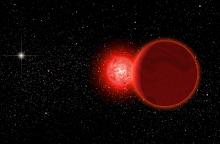Listen to today's episode of StarDate on the web the same day it airs in high-quality streaming audio without any extra ads or announcements. Choose a $8 one-month pass, or listen every day for a year for just $30.
You are here
Mars and the Twins
Watching Mars over the last few months has been like watching the taillight of a car disappearing slowly into the distance. Last October, it was the third-brightest object in the night sky — a brilliant orange beacon that was in view all night. But it’s been driving away from us ever since then. So now, it’s only about two percent as bright. It’s still easy to see, but it’s harder to separate from the distant traffic.
Mars is a bit easier to see the next few nights, though, because it lines up with two other lights that are roughly the same brightness: Pollux and Castor, the “twin” stars of Gemini.
Mars was so spectacular last fall because it was passing opposite the Sun in our sky, so it was quite close — less than 40 million miles away. Now, though, it’s on the other side of the Sun from us — more than 200 million miles away.
The extra distance accounts for most of the difference in brightness, but not all. When a planet is opposite the Sun, it reflects more of the sunlight that strikes it in our direction. Put the two factors together, and they add up to one thing: Mars is fading fast.
Look for it low in the west-northwest not long after sunset. It looks like a moderately bright star. The twins are to the right of Mars, with brighter Pollux closer to it. Mars will form an almost perfect line with them tomorrow and Tuesday. After that, the stars will drop away from Mars as the Red Planet slowly drives into the sunset.
Script by Damond Benningfield






